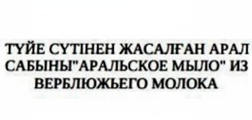|
Indication of the place of production of the goods (boundaries of the geographical object):
The production of Aral soap from camel milk is carried out in the Aral region - Kyzylorda region
The connection between the characteristics of the product and its place of origin (production):
Ingredients for soap production
The following ingredients are used in the production of natural soap: natural camel milk, camel oil or coconut oil, palm oil and safflower oil. To improve the quality of products, studies were conducted on various components and products, as a result of which our choice was made on high-quality products in the area, namely natural camel milk from the area of Aralsk city.
Geographical area of production and components
Camel hump liquid oil is a local component, as well as its own production for its own production needs. Coconut oil (Malaysia), safflower oil from Taraz. The main component reflecting the characteristics of the product is natural camel milk, which is produced by local farms located in the city of Aralsk, Kyzylorda region, characterized by a special composition of milk.
Vegetation in the area
Camel thorn grows in the Aral steppes, and it is correctly called "Zhantak". It is the camel thorn, which is consumed by camels, that makes camel milk valuable and curative. The climate in the area is sharply continental. The summer is very hot, arid, the soil is clay, saline. All this creates favorable conditions for its germination. In addition, other unique plants grow in the Kyzylorda region, such as wormwood, lerkha, calligonum bushes, sandhill wattle, eremopyrum, sedge and others, which have unique medicinal properties.
Description of "camel milk"
Camel milk is white in color with a characteristic milky odor, the intensity of which is determined by the feed and the quality of the water; thicker than cow's milk and surpasses it in nutritional value. Camel milk contains a significant amount of antibacterial compounds, and the number of lactobacilli and bifidobacteria is very small, which provides longer-term resistance to the temperature regime of milk storage. Camel milk contains more phosphorus and calcium, and a relatively high fat content is a feature of camel milk. With unpretentiousness and scarcity in the diet of camels in natural conditions, they are able to produce about 2000 liters of milk per year. Milk productivity during lactation in bactrians is 1-1.7 thousand liters, bactrian milk contains 4.5% protein, 5.2% fat, 5% carbohydrates; in dromedaries, productivity leaves 3.4-5.2 thousand liters, while milk contains 3.6% protein, 4.5% fat, 5% carbohydrates
Composite elements
An important component of natural soap is safflower oil. Sanflora oil is a rich source of monounsaturated and polyunsaturated fatty acids. It contains linoleic acid, palmitic acid, oleic acid with impurities of stearic acid, arachinic acid and myristic acid, which are responsible for the activity of serotonin derivatives and the absorption of vitamin E. The oil also contains vitamin K, which is responsible for the restoration of blood vessels. The oil is absorbed very quickly and penetrates deeply into the epidermis, therefore it is actively used to nourish the skin. The electronic oil supply is carried out by cold pressing from purified safflower seeds grown on the basis of bio-organic farming methods.
General characteristics of soap
The surface of the soap is smooth, without a pattern, without white plaque, deformations, cracks, oily secretions. It has a specific soapy smell. The consistency is firm to the touch, not sticky. The mass fraction of sodium chloride is 0.6, the mass fraction of free carbon dioxide is 9.43, and the solidification temperature of fatty acids isolated from soap is - 28 degrees.
|

